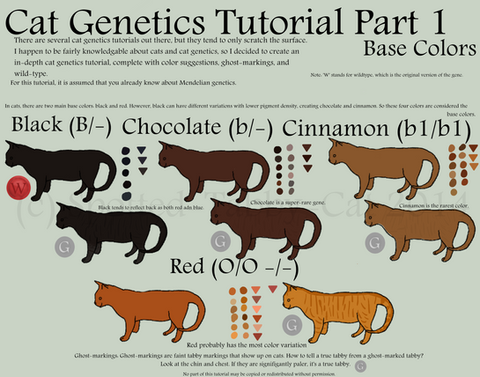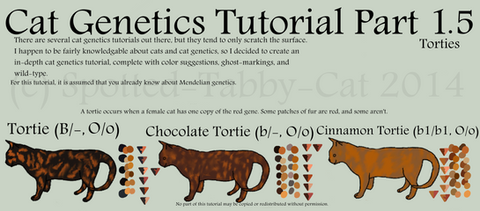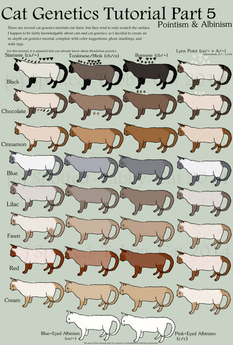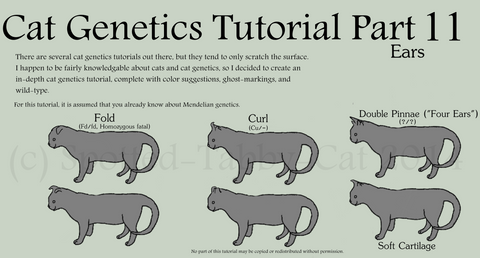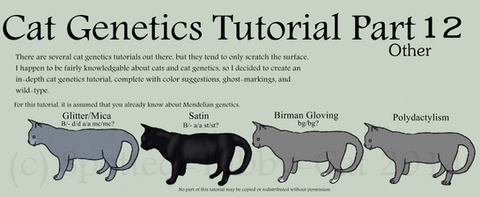HOME | DD
 Spotted-Tabby-Cat — Cat Genetics Tutorial Part 3 (Tabby/Agouti)
Spotted-Tabby-Cat — Cat Genetics Tutorial Part 3 (Tabby/Agouti)

Published: 2014-12-03 01:27:50 +0000 UTC; Views: 57770; Favourites: 374; Downloads: 249
Redirect to original
Description
This tutorial is out of date. Please see more information here .
There are multiple cat genetics tutorials about, but they tend to only cover the basics (base colors, dilutions, tabby, white-spotting, pointism, & tortie/orange). In-depth cat genetics tutorials tend to be lacking. So thus, this. I have no idea how long this will take to be completed. Hopefully before 2016.
Now we are into markings. Tabby/Agouti is one of the most common markings. It is a dominant gene that turns a solid cat into a tabby, and is represented by an A/a. Torbies are tortoiseshells that are also tabbies. Most torbies have pelts with less distinct and smaller pelts than is shown here. All the colors exhibit the mackerel tabby pattern. The bottom part shows the other possible patterns. The first is spotted tabby, which has an unknown cause. It might be a dominant gene with a recessive activation gene, or just a dominant gene. To add to the confusion, it might be that spotted tabbies only cause spots on areas that would otherwise be marked (classic and mackerel tabbies would have different spotted variations), or just mask all other tabby patterns with spots. It's even possible that there are two genes, one masking and the other morphing. Classic tabby and mackerel tabby is caused by the Mc/mc gene, with the dominant version causing mackerel and the recessive version causing classic. Ticked tabbies are caused by the T/t gene, with the dominant version being a ticked tabby and the recessive being non-ticked. Ticked tabbies also tend to show primitive or residual markings, namely stripes on the tail, legs, and neck. Only tail markings are shown here, but generally all the primitive markings follow mackerel tabby patterns. Broken mackerel tabbies are another genetic mystery, as are braided, or candle-flame, tabbies. Braided tabbies appear most often in wild/domestic hybrids. Marbled, oceloid, and rosette tabbies are from genes introduced from wild crossbreeding, and we don't know what causes them. However, on rare occasions, purely domestic cats have exhibited marbled tabby patterning. Sokoke classic tabbies are classic tabbies with the recessive version of the Sk/sk gene. Notice the faintly lighter insides of the markings on the Sokoke classic tabby.
Key:
Colored Circle - Color variations/suggestions
Colored Triangles - Nose leather colors
Part 1 (Base Colors):
Cat Genetics Tutorial Part 1 (Base Colors)
Part 1.5 (Torties):
Cat Genetics Tutorial Part 1.5 (Torties)
Part 2 (Dilutions):
Cat Genetics Tutorial Part 2 (Dilutions)
Part 3 (Tabby):
Cat Genetics Tutorial Part 3 (Tabby/Agouti)
Part 4 (White-Spotting):
Cat Genetics Tutorial Part 4 (White)
Part 5 (Pointism & Albinism):
Cat Genetics Tutorial Part 5 (Pointism & Albinism)
Part 6 (Silver & Gold Series):
Cat Genetics Tutorial Part 6 (Silver & Gold Series)
Part 7 (Color Changes):
Cat Genetics Tutorial Part 7 (Color Changes)
Part 8 (Weirdos):
Cat Genetics Tutorial Part 8 (Weirdos)
Part 9 (Hair):
Cat Genetics Tutorial Part 9 (Hair)
Part 10 (Tail):
Cat Genetics Tutorial Part 10 (Tail)
Part 11 (Ears):
Cat Genetics Tutorial Part 11 (Ears)
Part 12 (Other):
Cat Genetics Tutorial Part 12 (Other)
Related content
Comments: 28

👍: 0 ⏩: 0

👍: 0 ⏩: 0

👍: 0 ⏩: 0

Hey there! It's been so long, and I keep coming back to these tuts :')
Anyways, I was poking around the internet looking to see if any further studies had come out about spotted patterns, and I stumbled across this study: www.ncbi.nlm.nih.gov/pmc/artic…
It suggests that spotting is caused by the modification of mackerel, and may cause varying phenotypes such as broken mackerel via multiple loci. I thought you might find it interesting, and that maybe it could help some other people too
👍: 0 ⏩: 0

I've got a question about dilute tabbies. I'm getting some mixed answers on them.
So some resources seem to be indicating that a B/-, dd, A/-, ii cat would be a light brown color, and that to get a gray (blue) tabby, you need to have the I gene present. But a lot of your tutorials, as well as others, are indicating that the dilute gene would get you a blue tabby rather than a pale brown and black. Is that correct? Is a pale brown and black tabby just natural color variation? Thank you!
Edit: Also, do you know anything about eye color genetics in cats? Is it mostly the same as humans, Brown > Green > Blue? They have so many more colors than us...
👍: 0 ⏩: 1

Blue tabbies (B/-, dd, A/-, ii) cats do tend to look a bit like a light brown or buff color with grey stripes. (examples: thumbs.dreamstime.com/b/blue-t… , www.pets4homes.co.uk/images/cl… ) This is because they are essentially diluted brown tabbies, so the brown becomes buff and the black becomes grey. They do tend to look a little more grey though as the ticking of grey on buff gives an overall more grey appearance than the ticking of black on brown gives a black one (example: upload.wikimedia.org/wikipedia… ). Looking in 'softer' areas such as the chest, cheeks, underbelly, and paws can often show some of the buff coloration. As for a cat with a pale brown body coloration and black stripes, that would probably just be color variation of a standard brown tabby. Generally, they don't get too pale, but some ticking can appear almost white, so weird stuff can happen. (examples: www.lequoiacats.com/images/F5.… (this one is fairly solid, paler brown) previews.123rf.com/images/muan… (this one has more of the looking almost like white ticking appearance)). Grey/silver cats with black stripes are brown tabbies with the inhibitor gene (B/-, D/-, A/-, I/-). Silver on a blue tabby will often have minimal contrast and even less buff (example: www.maine-coon-cat-club.com/br… ). In general, the color of the stripes reveals the base color of the cat, although be aware of variation (example of cat with dark grey stripes that could be mistaken for black-based instead of blue-based: static6.depositphotos.com/1067… )
As for eye color, not much is really known about the genetics of it. Certain eye colors are linked to certain coat colors, and in general diluted cats tend to have lighter colored eyes. I would say that shades of brown and yellow are probably most common. Blue eyes tend to be linked to either white spotting, pointism/albinism, or some variety of rare mutations. MessyBeast discusses some of these here . It's generally easiest to think of cat eye colors on a spectrum, with brown/copper eyes on one end and green/aqua eyes on the other and yellow, hazel, orange, etc. in the middle.
Hopefully I've helped clear things up for you, if not, feel free to ask for clarification!
👍: 0 ⏩: 0

Perhaps looking at the colors, my cat might be a chocolate torbie... since the chocolate one has that lighter tannish-gray color that she has with her red tortie part...
👍: 0 ⏩: 0

I'm not a connoisseur of cat lore or genetics, but I find it interesting that a cat I had years ago (1970's), bred in a remote location in New Mexico where they were considered a matter of pride, was a dominate white born with a small black spot on her forehead which disappeared after she began to attain breeding maturity. Her first litter had one black, one gray, and one white like herself. Subsequent litters were also small and had at least one like herself. We moved from where we lived and she never got pregnant until we went back to visit where we had moved from and took her with us. Thank you for the tutorial, it is illuminating.
👍: 0 ⏩: 1

What an interesting story! I'm glad you found the tutorial enlightening.
👍: 0 ⏩: 0

I have a probably obvious question that's annoying me: Would a brown tabby [Brown/black stripes] be chocolate based or black based?
👍: 0 ⏩: 1

A brown tabby such as you describe would be black based. In general, the color of the stripes is the color of a base.
👍: 0 ⏩: 1

Next question: In your guide you missed out the dilution modifier, any reason why?
👍: 0 ⏩: 1

Huh, I guess I did. It must have completely slipped my mind due to its rarity and the fact that I've never really seen one. I might need to add an addendum!
👍: 0 ⏩: 0

Well, if you insist. It's here to help all learn.
👍: 0 ⏩: 0

How come the ticked tabby pattern is marked as a wild type?
👍: 0 ⏩: 1

I'm pretty sure I marked it as wild type because I thought it was the wild type, but looking at it now, mackerel tabby is probably the likelier candidate.
👍: 0 ⏩: 1

The brown (black gene) ticked tabby may be another wild type as many near eastern wildcats (Felis silvestris lybica), which domestic cats come from, look like brown ticked tabbies with leg and tail stripes. There are also many near eastern wildcats that look like the brown (black stripe) mackerel and broken mackerel tabbies, so brown mackerel tabbies are a wild type.
👍: 0 ⏩: 0

The white tail tip appears to be common in cartoon cats (i.e. Sylvester of Looney Tunes, Tom of Tom and Jerry, and Figaro in Pinocchio), but uncommon in real life cats.
An example of an inaccurate white spotting marking is white patch-type marking on one or both eyes. Cats have a white or light line-type marking on the around the rims of their eyelids as part of the tabby/agouti pattern. Many cartoon cats have white or lighter-than-their-base-fur-color patch-type markings around both eyes, but that is not really seen in real life cats.
👍: 0 ⏩: 1

So true about the whitetail tips. It's even worse when the cat is solid except for a white tail tip. Every cat that I know of with a white tail-tip has more white-spotting.
Again, very true about the lighter/white, or in some cases darker/black, eye patches. Speaking of the lighter markings around tabby eyes, your comment reminded me that I forgot that on the nlilac torbie, so thanks for reminding me.
👍: 0 ⏩: 1

There are also some cartoon cats that have darker feet and/or face or muzzle that aren't part of pointism (point/Siamese, mink/Tonkinese, and sepia/Burmese), and some white cartoon cats with peach-colored faces or muzzles and/or bellies. Neither are really seen in real life cats.
There can be real life cats that appear white with peach-colored faces, but they are cream point and also have peach-colored ears, legs, and tail. Also, a smoke cat can appear to have a darker colored face.
👍: 0 ⏩: 1

You really seem to have a handle on common cat coat mistakes.
👍: 0 ⏩: 0

Is there going to be a feet marking section and a face marking section for the white spotting section of the tutorial. There are many illustrations focusing on the various different white markings found on a horse's face and feet/hooves, but very few illustrations like that for a cat's feet/paws and none for a cat's face.
👍: 0 ⏩: 1

As far as I know, there is no official name for the facial and paw markings, but the spread on the main body, white-on-paw variations, and spread on the face will be shown.
👍: 0 ⏩: 0

I love this resource.
There are a few tabby patterns that you missed, the ticked tabby with neck, tail, an leg stripes, the classic-tabby-based spotted tabby, and a tiny-spot pattern called the freckled tabby.
The marbled tabby pattern is sometimes seen in cats without Bengal or other hybrid cat breed ancestry.
👍: 0 ⏩: 1

I'm glad that it's helping someone.
I did leave out the primitive markings on the ticked tabby. I should probably mention them somewhere. The freckled tabby I can imagine as somewhere between the ticked and spotted tabby. I've honestly never heard of them before. And as for the spotted classic tabby, from what I know spotted tabby masks all other tabby patterns and replaces them with spots instead of shrinking the pattern, like broken mackerel tabby.
I have not heard heard of any such cases, but I'll look into it. Thanks.
👍: 0 ⏩: 1

Yes, the spotted tabby pattern does mask the classic and mackerel patterns and turns the blotches and stripes into spots. However, the spots on the mackerel spotted tabby follow the mackerel pattern and the spots on the classic spotted tabby follow the classic pattern.
👍: 0 ⏩: 1

I did some research, and from I found out, no-one really knows. It's very possible that there are two (or more) spotted tabby patterns and one 'breaks' up the markings and creates distinct spots only in areas which would have stripes, and another that just adds spots. I'll edit the description and mention this. Thank you.
👍: 0 ⏩: 0


